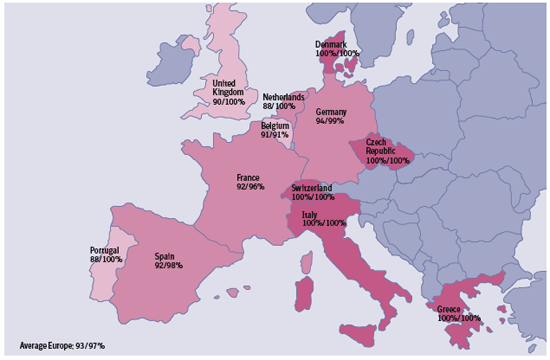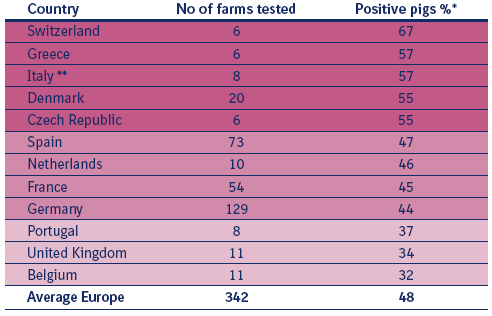2.1.3 What are the differences in the prevalence between European Countries?
The main pig producing countries in Europe – Germany, Spain, Denmark and France– provided the majority of information for the Ileitis survey.
There is a very high level of infected pigs and infected farms in Europe without clear distribution preferences of the disease. Across Europe between 34% and 67% of pigs and 88% and 100% of farms are infected with L.intracellularis (Fig. 2.1.3 a; Table 2.1.3 b). The highest percentage of positive pigs and positive farms are found in Denmark, Switzerland, Czech Republic, Greece and Italy. Countries with a comparatively low prevalence are Portugal, United Kingdom and Belgium. Spain, France, Germany and The Netherlands rank in between (Table 2.1.3b).

Figure 2.1.3 a
Percentage of serologically positive farms in European countries.
(A herd was considered
positive when at least one animal was tested ELISA positive for L. intracellularis in the sow unit or in the fattening unit. The prevalence is shown in sow and in fatteners
before slaughter, respectively.)

Table 2.1.3 b
Percentage of serologically positive pigs and serologically positive farms in European countries (for the prevalence per age group see Table A.1 a and Table A.1 b in the Appendix) .
* Average percentage positive of all tested age groups.
** The average percentage of positive pigs in Italy is influenced by the additional screening of pigs 35 weeks of age.
The widespread distribution of infection suggests that the disease is endemic on most of the farms. With the majority of pigs not showing obvious diarrhoea, sub-clinical Ileitis as hidden “background disease” is probably the most frequent form of Ileitis in practice. The nature of the disease has been described as: “Always around and causing economic trouble (increased feed consumption, slower weight gains and increased building costs), but not always visible” (McOrist et al. 2003). It can be hypothesized that common antibiotic feeding practices may have contributed to the sub-clinical presentation of the disease. Here it is interesting to remember that after the complete prohibition of antibiotic growth promoters in Denmark Ileitis was recognized as a clinical problem in many farms without any disease history before the ban (Møller Jensen 2003).
The comparison of ELISA values from Denmark with the average ELISA profile of other European countries revealed that the Danish ELISA-values were significantly higher at the end of the nursery as well as in fattening pigs 13 th and 18 th week compared to the European average (Figure 2.1.3c).

Figure 2.1.3 c
Ileitis ELISA values in Europe and Denmark.
* means with non overlapping 0.95 confidence intervals are significantly different.
The infection which triggers such an early seroconversion in Danish farms takes probably place in early to mid nursery. This is in good agreement with investigations by Vestergaard (2004) where seroconversion in Danish farms was detected as early as 6 weeks after weaning. In contrast to the Danish situation Wendt and Schulze Johann (2004) found a typical seroconversion for German farms about 7 weeks later than the typical seroconversion in Denmark. Both, the high average ELISA values and the early seroconversion are strong indications of the exceptional role of Ileitis in Denmark after the withdrawal of antibiotic growth promoters.
© Boehringer Ingelheim Animal Health GmbH, 2006
All rights reserved. No part of this Technical Manual 3.0 may be reproduced or transmitted in any form or by any means, electronic or photocopy, without permission in writing from Boehringer Ingelheim Animal Health GmbH.






